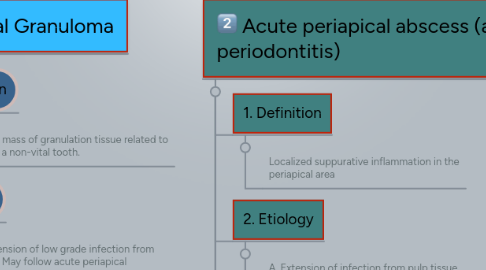
1. Periapical Granuloma
1.1. 1. Defenition
1.1.1. 1. Localized mass of granulation tissue related to the apex of a non-vital tooth.
1.2. 2. Etiology
1.2.1. 1. From extension of low grade infection from pulp tissue. May follow acute periapical abscess that has been inadequately drained and incompletely treated.
1.2.2. 2. Infection of the periapical area will produce inflammation with activation of osteoclasts to produce bone resorption and replacement of bone with granulation tissue.
1.3. 3. Classification according to location
1.3.1. 1. Periapical: When located in the area around the apical foramen.
1.3.2. 2. Lateral: When related to an accessory root canal.
1.3.3. 3. Inter-radicular: When related to an accessory root canal in the furcation area
1.4. 4. Clinically
1.4.1. 1. Related to non-vital tooth
1.4.2. 2. The patient feel that the tooth is extruded from the socket
1.4.3. No pain or slight discomfort on biting or chewing
1.4.4. The tooth is slightly sensitive to vertical percussion
1.5. 5. X-ray
1.5.1. 1. Well defined radiolueent area related to the apex.
1.5.2. 2. Root resorption may be noticed
1.6. 6. Histologically
1.6.1. 1. Fibrous connective tissue capsule
1.6.2. 2. Granulation tissue
1.6.3. 3. Chronic inflammatory cells
1.6.3.1. 1. Chronic inf Cells
1.6.4. 4. Cholesterol clefts
1.6.5. 5. Macrophages to engulf cholesterol (foreign material) foam cells
1.6.6. 6. Foreign body giant cells
1.6.7. 7. Epithelial cells may be seen from:
1.6.7.1. 1. Epithelial rests of Mallassez
1.6.7.2. 2. Respiratory epithelium in case of sinus perforation.
1.6.7.3. 3. Oral epithelium growing through a fistula
1.6.7.4. 1. Oral epithelium from a periodontal pocket
1.7. 7. Treatment
1.7.1. 1.Extraction of the involved tooth.
1.7.2. 2.Endodontic treatment
1.7.3. 3. Endodontic treatment with apicectomy and curettage of the granuloma
1.8. 8. Fate of granuloma
1.8.1. 1. With effective endodontic treatment, granuloma will heal. Healing occurs by fibrosis and scarring of granuloma with disappearance of inflammatory cells, bacteria and decrease vascularity.
1.8.2. 2. Without treatment, granuloma may progress into radicular cyst or undergoes acute exacerbation into acute periapical abscess.
2. Acute periapical abscess (acute apical periodontitis)
2.1. 1. Definition
2.1.1. Localized suppurative inflammation in the periapical area
2.2. 2. Etiology
2.2.1. A. Extension of infection from pulp tissue
2.2.2. B. May follow faulty endodontic treatment
2.2.3. C. May result from acute exacerbation of periapical granuloma
2.2.4. The causative organisms are pyogenic bacteria
2.3. 3. Clinically
2.3.1. 1. Severe throbbing pain
2.3.2. 2. Tooth is extremely painful, even to touch.
2.3.3. 3. Tooth is usually extruded from the socket
2.3.4. 4. Tooth is non-vital, no pain with thermal changes and no response with electric pulp tester
2.3.5. 5. History of pain due to previous pulpitis
2.3.6. 6. Systemic manifestations(fever and malaise
2.4. 4. X-ray
2.4.1. 1. In the early stas.es, no changes can be seen because bone changes need time to develop.
2.4.2. 2. Then , the lamina dura becomes hazy with widening of the periodontal membranes space.
2.4.3. 3. Later, lesion appears as hazy or ill-defined radioluccnt area
2.5. 5. Histologically
2.5.1. 1. In the early stages, intense inflammation in the immediate vicinity of the apex.
2.5.2. 2. If not immediately treated, definite abscess is formed which consists of:
2.5.2.1. 1.Central area containing pus(dead and living microorganism, dead and living PNL and liquefied tissue depris)
2.5.2.2. 2.Surrounded by pyogenic membrane which is a layer of fibrin heavily infiltrated with PNL.
2.5.2.3. 3. The surrounding tissues show dilatation of blood vessels, edema and infiltration with chronic inflammatory cells and histocytes.
2.6. 6. Treatment
2.6.1. Extraction of tooth or drainage of pus through the root canal followed by endo ttt for the tooth to be preserved.
2.7. 7. Prognosis
2.7.1. 1. If not treated, further spread of infection can cause inflammation of the surrounding bone (osteomyelitis) or cellulitis.
2.7.2. 2. Pus may penetrate the overlying bone and periosteum through a sinus giving immediate relief of symptoms, thus condition changes from acute to chronic abcess.
2.7.3. 3. Improperly treated abscess may result in chronic abscess

